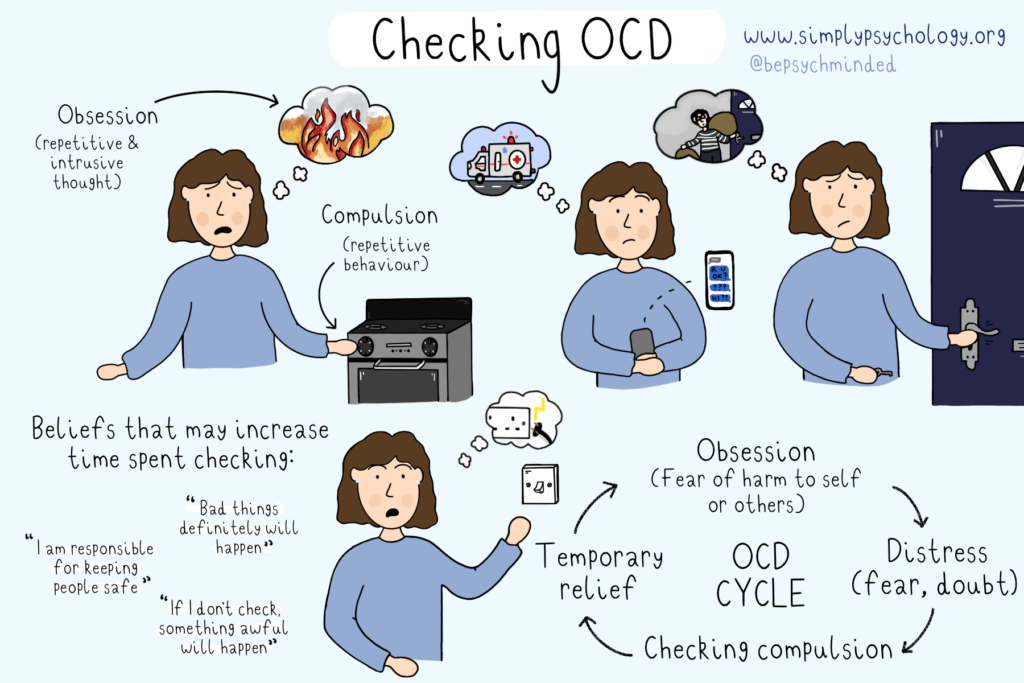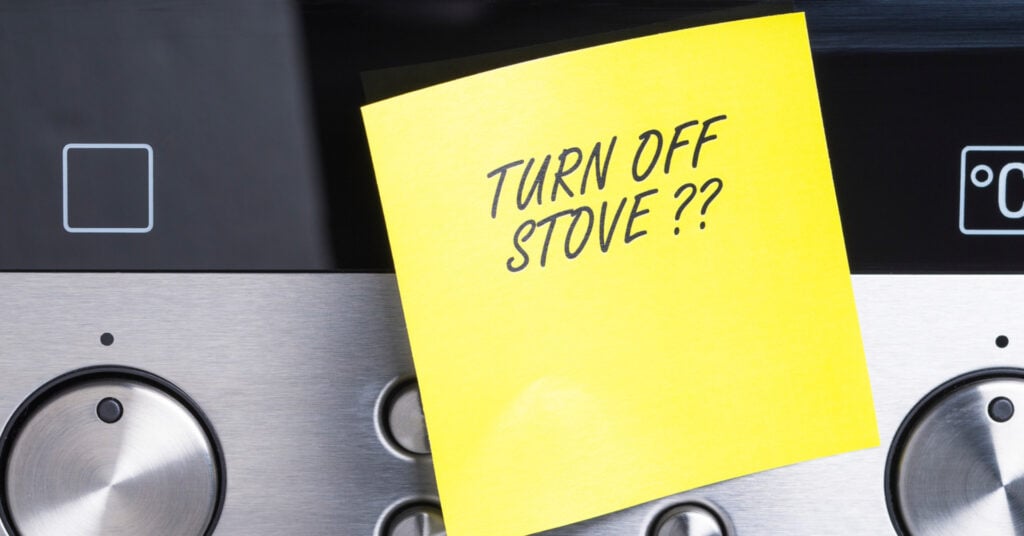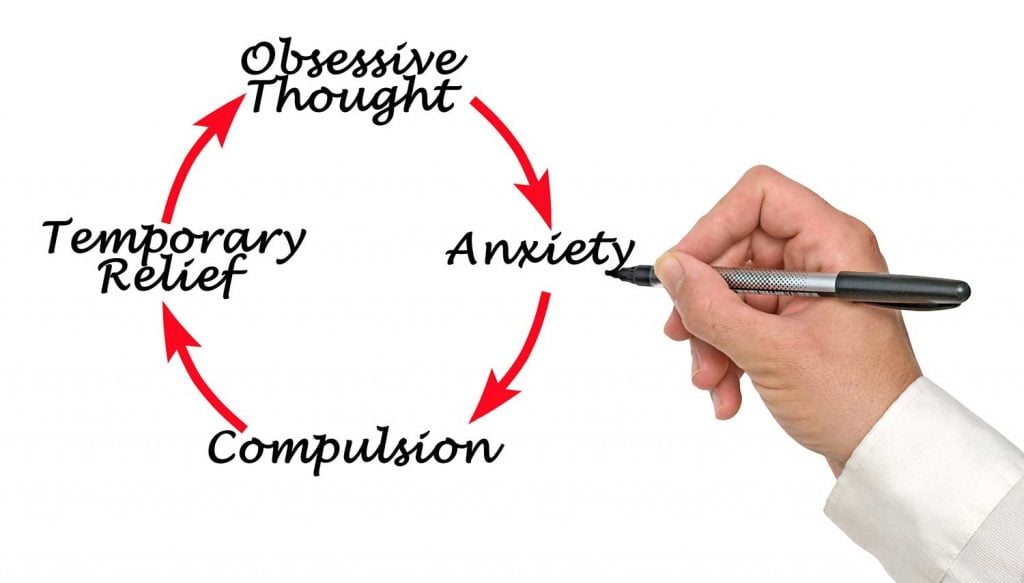On This Page:
Checking OCD is one of the most common forms of obsessive-compulsive disorder, characterized by checking-based compulsive behaviors. Checking is also a symptom of various other OCD subtypes.
A person with checking OCD will go back to check repeatedly to ensure everything is as it should be. And even still, they may still not genuinely be convinced it is okay.

Individuals who suffer from checking OCD often fear that they will somehow cause harm to themselves or others, whether intentionally or not.
Like most forms of OCD, Checking OCD looks different for everyone and can manifest in several ways. OCD-related checking is typically driven by a need to be certain that nothing bad will happen.
It is associated with excessive anxiety, feelings of guilt, elevated vigilance, perfectionist tendencies, resistance to change, and an inflated sense of responsibility (Radomsky et al., 2010, 2022).
Two triggers for checking compulsions to occur:
- People feel like it’s their job to make sure nothing bad happens.
- They’re not sure if they did enough to stop something bad from happening.
How long and how strong the checking is will depend on three things:
- If they feel even more responsible for preventing harm.
- If they think there’s a bigger chance of something bad happening.
- If they think something really bad will happen if they don’t check.
Checking Obsessions
Obsessions often take the form of repetitive, persistent ideas, unwanted or intrusive thoughts, images, or bodily impulses that are experienced as distressing.
The obsessive thought creates a sense of anxiety and fear. In theory, checking OCD can involve obsessions about anything.
For example, someone who fears leaving the door unlocked may be afraid that someone may break in and steal their possessions, or cause harm, and that they would be responsible for not having checked the lock initially.
According to Jon Hershfield, MFT, director of The Center for OCD and Anxiety:
“People describe for me that they are sort of reading this spam junk mail that’s coming into their feed marked as urgent and they don’t know, are they supposed to ignore it, or are they supposed to open it and reply to it, which then teaches the algorithm to send you more of that stuff.”
When people pay excessive attention to their intrusive and obsessive thoughts, they may find it more difficult to get rid of them.
Some of the more common obsessions include:
- Fear of causing a fire by leaving the stove or oven or any other electrical appliance on.
- Fear of hurting someone or being hurt.
- Fear of your child being harmed under your care (i.e., not childproofing the outlets properly).
- Fear of losing items such as your phone, wallet, or keys.
- Fear of leaving the door unlocked or the garage open.
- Fear of contamination and causing illness.
Generally, people attempt to resist thinking of the obsession and get rid of the thoughts. But as people resist, the intrusion persists.
Checking Compulsions
Compulsions are repeated patterns of ritualistic behaviors, used to reduce anxiety and prevent an outcome, following a strong obsessive urge to do so.
Individuals suffering from Checking OCD will use checking compulsions to counter their fear-based obsessions. They believe that the best way to prevent something bad from happening is to use a compulsive checking ritual.
These rituals tend to be repetitive and time-consuming and only serve to relieve anxiety temporarily. Compulsively double-checking things can make you feel like a prisoner trapped by your intrusive thoughts.

Some common Checking OCD compulsions include:
- Checking that the stove, oven, and any other electrical appliances are turned off.
- Checking that the garage is closed and all doors are locked.
- Checking that car doors are locked.
- Checking that candles are blown out.
- Checking that the sink and other water faucets are turned off.
- Getting out of their car to ensure they did not hit someone after going over a bump.
- Checking newspapers or watching the news to make sure nothing terrible has happened that they might be responsible for.
- Checking that their children are safe or that their baby is still breathing.
- Checking to make sure their personal items are in the proper place.
- Taking photos for lasting “proof.”
- Seeking reassurance, such as asking other people questions such as “You saw me lock the door, right?”
- Avoiding responsibilities, such as getting someone else to be the last to leave the house.
- Spending hours going over conversations in your head to be certain you did not say anything hurtful or inappropriate.
- Calling loved ones repeatedly to make sure they are safe.
The Checking OCD Cycle
Having unwanted thoughts, images, or urges (bodily sensations) of doing or saying something that will harm yourself or others is a very normal part of how our brains work.
People with and without OCD have these thoughts. It is not the thoughts themselves that are the problem, but rather the meaning OCD sufferers attribute to them.

These obsessive concerns cause anxiety and fears, which trigger OCD sufferers to perform compulsions to gain certainty that something terrible has not or will not happen.
Because anxiety is only relieved in the short term, the vicious, obsessive cycle of OCD will continue with the next intrusive thought.
Put simply, some event or thought will trigger an intrusive thought which gives rise to anxiety that, in turn, is responded to with a compulsion that eventually creates a sense of temporary relief.
When the anxiety is reduced in this way, the compulsion will be reinforced and grow stronger.
So, the next time an intrusive thought arises, you are even more inclined to perform a compulsion (in this case, you are more inclined to keep checking).
For Example
A woman is constantly late for work due to her obsessive checking. Even though she woke up early and was ready to leave in time, she was stuck at her house, bombarded with intrusive thoughts.
Did I remember to turn off the stove? Did I unplug the toaster? Are all of the doors locked? What if a fire starts when I am not home?
She worries that her carelessness could result in tragedy. She gets stuck in a downward spiral of anxiety, doubt, and repetitive checking.
After performing her compulsions by assuring everything is locked and turned off multiple times, she becomes even more entrenched in the cycle.
Real-Life Examples
“I spent several months compulsively checking my social media profiles and even comment sections on Youtube, Instagram, etc., every morning after waking up and as much as possible during the day, in order to see if I hadn’t posted, commented or liked anything I didn’t mean to. Same goes to messaging apps.”
“I am always careful when I go out to check and make sure I have my purse. One day I left my purse in a restaurant, and I never got it back. There was not much money in it, but it was so difficult replacing all the cards and cancelling my credit cards.
So now I always check around and under the seat I have been sitting on and actually make a habit of touching my purse to be certain I have it with me.”
Effects of Checking OCD
As with all types of OCD, the more a person engages in the obsession-compulsion cycle, the stronger the OCD can become, and the more the individual will distrust their own memory.
The pressure and exhaustion associated with this cycle can lead to other mental health conditions, such as anxiety and depression.
Checking OCD can have a severe impact on one’s daily life. It can feel impossible to focus at work, school, or with your loved ones when your mind is constantly preoccupied with your obsessive thoughts.
The condition can make it challenging to hold a job, drive a car, maintain a relationship, or simply leave the house. Suicidal thoughts, attempts, and self-harm behaviors have also been observed in those experiencing OCD.
People with extreme OCD will spend several hours daily repeating specific checking behaviors to relieve their overwhelming anxiety.
For example, someone with Checking OCD may be unable to leave the house for over an hour due to repeatedly checking the stove.
How To Stop Repeatedly Checking Everything
Checking OCD should not be solely self-managed, and working with a mental health professional is critical. But, in tandem with this, there are some daily self-help steps you can take to ease the impact.
1. Do not identify with OCD
You are not the disorder, and your OCD does not define you. Yes, it is something you are dealing with, but you are not a defective human because of it.
The intrusive thoughts you experience are not necessarily a reflection of who you are and do not say anything about you as a person. Try to remember that intrusive thoughts are common and do not always align with your core values, beliefs, and morals.
Learn to appreciate yourself for who and how you are and practice leaning in, embracing, and accepting your unwanted thoughts, feelings, and sensations.
“Learning to stop ruminating is a really good first step. You also have to change your relationship with anxiety, if you are trying just to seek relief from anxiety at all costs via any means necessary it won’t work.
You have to be willing to feel the entirety of your anxiety and continue on with your life regardless.”
Tip 1: Identify and Challenge Maladaptive Thoughts
Keep a thought log to identify situations that trigger obsessive thoughts and your negative automatic thoughts about them.
Examine the evidence for and against the fearful thoughts. Ask yourself “What is the likelihood this catastrophic outcome would actually happen?”
Try to come up with more balanced thoughts. For example, “Just because I feel something bad will happen doesn’t mean it actually will.”
Tip 2: Reduce Avoidance
Don’t avoid triggering situations as this prevents learning that feared consequences likely won’t happen.
Make a list of situations you tend to avoid due to OCD fears. Rank them from least to most anxiety provoking.
Gradually confront the least anxiety-provoking items on your list, working your way up. Avoid compulsions during and after.
Remind yourself avoidance prevents learning the feared outcome likely won’t happen. Tolerating uncertainty gets easier.
Tip 3: Practice Mindfulness
Stay focused on the present moment to avoid getting caught up in obsessive thoughts. Notice them non-judgmentally.
Imagine the thoughts floating away like clouds. Don’t judge yourself for having them. Bring your attention fully to your current activity whenever obsessions creep in.
Tip 4: Call An Obsession By Its Name:
When your OCD voice tries to convince you that you forgot to do something, identify it as an obsessive thought. Tell yourself that this is not the truth and just my OCD talking.
2. Why Compulsions Make Your Intrusive Thoughts Worse
People perform these compulsions in order to suppress their anxiety and neutralize their fears. They also carry them out to keep things safe, make sure that the thoughts do not come true, and make sure that something bad does not happen.
However, while compulsions might “help” in the short term, they only make the intrusive thoughts worse and serve to keep the OCD cycle going long-term.
Every time one engages in a compulsion related to the obsession, the thoughts will only become stronger in a powerful and debilitating loop.
Compulsions will never make the intrusive thoughts go away; they will only reduce your anxiety and give you a short-term reprieve from your thoughts.
If your brain has a pattern of carrying out a compulsion each time you get an intrusive thought, you will never learn to recover.
“If I was feeling the need to do something based on an intrusive thought, I just wouldn’t do it and I’d survive, reinforcing that I had survived and nothing had changed. It’s to the point for me where I still have stupid intrusive thoughts, but I don’t act on them unless I’m super stressed.Tip 5: Resist Urges to Check or Reassure
My life quality has increased tremendously from resisting urges based on thoughts. At this point sometimes I can go for weeks without engaging in a compulsion. I feel like I’m fine now. I just struggle with thoughts at times but it doesn’t run my life anymore like it used to.”
When you have an urge to check something, sit with the anxiety and allow it to pass without giving in to the compulsion.
Tell friends and family not to provide reassurance when you seek it compulsively. Explain this enables your OCD. Engage in an activity that requires focus and concentration, so you can’t give in to the urge.
Accept that uncertainty is part of life and you can cope with not knowing if family or friends may not be safe. Avoid trying to feel 100% sure.
Tip 6: Alter How You Check:
Reduce the number of times or time you spend on checking gradually. When you have an obsessive thought, do not give in immediately. Take a minute to sit with it and let the obsession lose its power.
Tip 7: Engage in Distractions
When you have the urge to check or obsess, shift your focus to another activity to take your mind off it.
3. Do Exposure Exercises
Make a hierarchy of triggering obsessional thoughts, objects, and situations. Rate how distressing they are from 0-100.
Start by exposing yourself to items ranked around 50. Work your way up over multiple sessions for at least 30-60 minutes.
Remind yourself habituation takes time. Urges and anxiety will eventually decrease on their own if you don’t perform compulsions.
Keep records of what happens after you manage to sit with your intrusive thoughts and resist the urge to engage in compulsions. Use these records as a way to build confidence in your own memory and to reduce the amount of checking you do.
Treatment
There is evidence that OCD can be well managed by treatment intervention, enhancing an individual’s quality of life significantly.
Like with most types of OCD, the best course of treatment for Checking OCD is Exposure and Response Prevention (ERP) therapy.
ERP is a type of Cognitive-Behavioral Therapy that is considered the gold standard psychotherapy for OCD and has been found effective for 80% of people with OCD.
In ERP for Checking OCD, patients are exposed to intrusive thoughts or feared situations to set off compulsions. This therapy is intended to purposely invoke more anxiety in attempts to disrupt the neural circuit between the processing and action parts of the brain.
Over time, patients learn to resist the urge to perform compulsive rituals and manage their OCD thoughts and actions. By staying in a feared situation without anything terrible happening, patients learn that their fearful thoughts are just thoughts and nothing else.
For example, for a patient who fears leaving the stove on and burning their house down, the goal of ERP therapy would be to allow this patient to leave their home without needing to re-check the stove multiple times.
In an ERP session, the patient may start by imagining that they left the stove on. They may even be asked to picture something terrible happening, such as their house catching fire.
The person is then instructed to refrain from checking the stove before leaving home. They eventually learn that despite their thoughts, the feared outcome won’t occur, and the anxiety will subside on its own.
This habituation process of repeatedly invoking anxiety and exposing the brain to a stimulus disrupts the neural circuit between the processing and action parts of the brain.
By sitting with the feared thought and leaning into the discomfort and uncertainty, patients learn that they don’t need their compulsions to cope, and that their fearful thoughts have no power over them.
Here is an example of a fear hierarchy for Checking OCD
The fear hierarchy is a collaborative effort between the individual and their therapist. The goal is to gradually expose the individual to the feared situations or stimuli while preventing them from engaging in compulsive behaviors or mental acts.
The list is arranged in a hierarchical order, starting with the least anxiety-provoking situation or stimuli (0% anxiety) and gradually progressing to the most anxiety-provoking (100% anxiety).
This exposure helps the individual to learn that they can tolerate the anxiety without resorting to compulsions or mental acts, and that the anxiety will eventually decrease on its own.
- Leave the house without checking the front door lock and walking a certain number of steps away from the house before going back to check. (15%)
- Leave the house without checking the front door lock and go for a walk around the block before going back to check. (30%)
- Leave the house without checking the front door lock and go to another room before going back to check. (45%)
- Leave the house without checking the front door lock and spend an hour doing something else before going back to check. (60%)
- Leave the house without checking the front door lock and go out for a few hours before going back to check. (75%)
- Leave the house without checking the front door lock and stay overnight away from home without checking. (90%)
- Leave the house without checking the front door lock and stay away from home for a weekend without checking. (100%)
ERP takes time, effort, and practice, but people learn to cope with their thoughts without relying on ritualistic behaviors.
The compulsion to avoid anxiety is a powerful driver of OCD. Still, ERP is one of the most powerful tools available for treating OCD because it directs the patient to live with the anxiety and see that nothing bad will happen.
How to Help Someone with OCD
Here are some tips for family members to help someone with checking OCD based on the attached article:
- Educate yourself about OCD and checking behaviors specifically. The more you understand the condition, the better you can support your loved one.
- Avoid participating in checking rituals or providing reassurance. This will only reinforce the OCD in the long run, even though it provides temporary relief.
Set healthy boundaries around what checking behaviors you will and will not tolerate or participate in. Make these clear to your loved one.
Remain calm and understanding if your loved one becomes distressed when you stop accommodating rituals. Explain you are trying to help long term.
Know that stopping rituals may initially increase anxiety for your loved one, but this will diminish if they persist with ERP. - Encourage the person to get professional treatment with exposure and response prevention (ERP) therapy and possibly medication. Do not force treatment, but let them know help is available.
- Avoid making personal criticisms. Do not ridicule or belittle checking concerns, as irrational as they may seem. Recognize the obsessions are very real to your loved one.
Demonstrate love and support in ways other than enabling rituals, like spending quality time together away from OCD topics.
Hotlines and Support In the U.S. Call the NAMI Helpline at 1-800-950-6264. Or Find a Therapist. UK Call Anxiety UK at 03444 775 774. Canada Find services at Anxiety Canada. Australia Call the SANE Help Centre at 1800 18 7263. India Call the Vandrevala Foundation at 1860 2662 345 or 1800 2333 330. In other countries Access a global database of OCD resources from the International OCD Foundation.
Sources
Cougle, J. R., Lee, H. J., & Salkovskis, P. M. (2007). Are responsibility beliefs inflated in non-checking OCD patients?. Journal of Anxiety Disorders, 21(1), 153-159.
Hershfield, J., & Corboy, T. (2020). The mindfulness workbook for OCD: A guide to overcoming obsessions and compulsions using mindfulness and cognitive behavioral therapy. New Harbinger Publications.
Radomsky, A. S., Alcolado, G. M., Dugas, M. J., & Lavoie, S. L. (2022). Responsibility, probability, and severity of harm: An experimental investigation of cognitive factors associated with checking-related OCD. Behaviour Research and Therapy, 150, 104034.
Radomsky, A. S., Shafran, R., Coughtrey, A. E., & Rachman, S. (2010). Cognitive-behavior therapy for compulsive checking in OCD. Cognitive and Behavioral Practice, 17(2), 119-131.
Strauss, A. Y., Fradkin, I., McNally, R. J., Linkovski, O., Anholt, G. E., & Huppert, J. D. (2020). Why check? A meta-analysis of checking in obsessive-compulsive disorder: Threat vs. distrust of senses. Clinical Psychology Review, 75, 101807.


